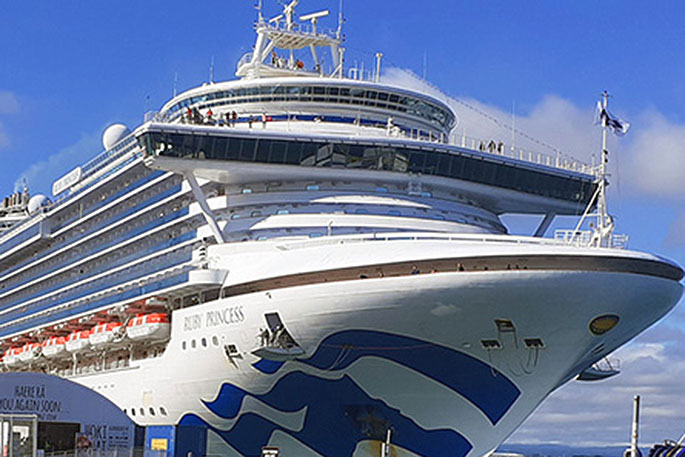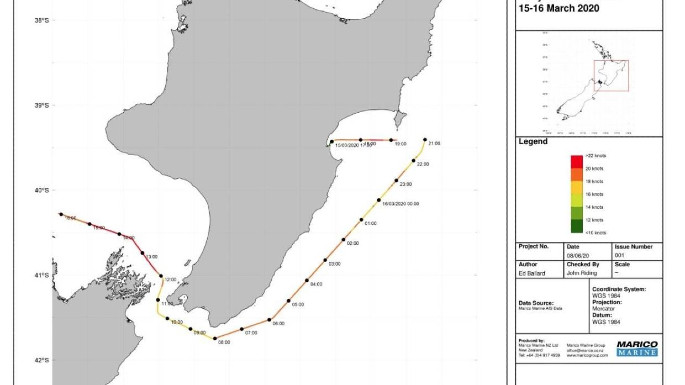We'll never know how much worse New Zealand's Covid-19 outbreak could have been had the Ruby Princess made it to Tauranga as planned, but emails released to Stuff under the Official Information Act show we were only about ten hours from finding out.
The ship carrying 2647 passengers and 1148 crew visited New Zealand between March 11 and March 15 before cutting its trip short and returning to Sydney, where it was discovered several sick passengers had Covid-19.
There are now 22 deaths and 700 cases of infection linked to the passengers and crew who disembarked in Sydney on March 19.
It's now known that at least one of those was showing symptoms before the vessel reached New Zealand.
Several people in Wellington and Napier, its last stop in New Zealand, were also infected after coming into contact with passengers.
In Napier the virus spread to rest home residents and several health workers.

Tauranga was to have hosted the Ruby Princess on March 16. Photo: Rosalie Liddle Crawford
While the virus went undetected as the ship rounded New Zealand, documents show that by the time it reached Wellington five people had come down with Influenza A.
The Hawke's Bay DHB on-call health protection officer received a health declaration from the ship's agents around midday on March 14, while the ship was docked in Wellington.
When the officer saw that there was a 25-year-old woman on board listed as having an ''Influenza Like Illness'' the ship's captain was told that unless she was shown to be free of Covid-19, the ship could not berth in Napier.
Urgent testing for Covid-19 by ESR was arranged. The woman and four other passengers were tested.
Shortly before 10.30pm, the medical officer of health in Hawke's Bay was advised that the tests came back negative and Napier Port was advised the vessel could berth, but because the woman was symptomatic she would have to remain isolated while the vessel was berthed.
The ship arrived in Napier at 6.30am on Sunday, March 15. Its passengers disembarked and toured the city and wider area. Unknown at the time, several were carrying Covid-19 and spread the infection.
An email from Hawke's Bay DHB was sent to the Health Ministry and the medical officer of health at Tauranga shortly after 11am, advising them of the steps that had been taken with regard to what was termed an outbreak of Influenza A.

Ruby Princess on a previous cruise into Tauranga harbour. Photo: Rosalie Liddle Crawford
The ship departed Napier at 4.20pm bound for Tauranga, where it was due to dock at 7.15am the next day.
At 4.23pm the duty health protection officer in Tauranga emailed the Health Ministry asking for clarification around the test results.
He did not receive a reply by email, but later that day the Bay of Plenty DHB received two declarations of health from the ship's agent. The first was emailed at 4.50pm as the boat headed east towards Mahia Peninsula. It informed the health protection officer that there were 18 people who had been ill onboard.
Of those, 12 had recovered, including the woman with the flu-like illness. The other six had Influenza A and were in isolation.
At 8.03pm a second, different, declaration of health was sent. This one, intended for Auckland but sent to Tauranga, said there were 22 people who had been ill, of whom 10 had Influenza A and were in isolation.
Strangely, although the declaration was intended for Auckland, a spokeswoman at Auckland DHB said it was never received.
It was around 9pm, when the boat was east of Mahia Peninsula and should have been heading north, that an announcement was made over the ship's speakers. Passengers were told that Australian Prime Minister Scott Morrison had announced several restrictions due to the Covid-19 pandemic that day, including that anyone arriving in Australia after midnight on March 22 (the day after the voyage was to end in Sydney) would need to self-isolate for 14 days. On that basis the ship was turning south and heading home, via Cook Strait.

Tracking of the Ruby Princess after it left Napier on March 15. Provided by Marico Marine.
At 9.02pm a health protection officer in Tauranga was still under the impression the ship was headed that way.
An email from the officer to the agent says: "As I understand it, nothing has changed with this vessel since the last port, no further sickness on board?"
No reply was sent to that email, but it is possible a call was made.
A spokeswoman at Tauranga Port said the ship's visit was cancelled on the evening of March 15, but could not say when. No reason was given for the cancellation.
The Health Ministry was told by the ship's agent that the decision had been made due to bad weather.
A Special Commission of Inquiry into the cruise ship heard last month that on March 17 - the day the ship was due in Auckland - the ship's medical logs showed about 50 people had presented for acute respiratory symptoms, with another 54 people presenting in the following 24-hours.
Tauranga Mayor Tenby Powell said there was no question the city and wider area was fortunate that the ship did not visit.
Cruise passengers visiting Tauranga tend to cover a much greater distance than in many ports, with bus loads making their way to Rotorua and others to Hobbiton, near Matamata.
The fact the city was home to the country's highest proportion of elderly people also meant it would have been particularly susceptible to an illness known to have its greatest impact on that age group, Powell said.
Anecdotally about half the passengers on any cruise ship visiting Tauranga either visited the city or stayed on board the ship, 35 per cent went to Rotorua and 15 per cent went to Hobbiton and surrounds.
"Obviously we were fortunate. We'll never know what effect it would have had," he said.
"We have the most people aged 75 and over than anywhere in the country. It's something like 13 per cent in most cities. Here it's nearly 20 per cent. I'm always very conscious of that and it was always in the back of my mind with Covid-19," he said.
He said the cruise-ship industry was worth about $90m a year to the region but, when they returned, changes would be needed.
"I would anticipate there would be some changes that up the ante with checks and balances as people depart, and that's a good thing, because we now know people can disembark from cruise ships when they're unwell," he said.
 Dr Siouxsie Wiles says it's hard to know if Napier was lucky, or unlucky . Photo: Peter Meecham/Stuff
Dr Siouxsie Wiles says it's hard to know if Napier was lucky, or unlucky . Photo: Peter Meecham/Stuff
Microbiologist Dr Siouxsie Wiles said the number of incursions would depend on how many infected passengers had disembarked, the number of people they came in contact with, and the sorts of environments that contact happened in.
"It's very hard to know as our knowledge of this virus is improving all the time, particularly around the sort of environments in which it is most likely to be transmitted. In a badly-ventilated environment, where people are close together, it is likely to spread more," she said.
"If one infected person got off and went on a bus there is a risk of transmission. If 10 people got off and went on several different buses there is a greater risk. But it all depends on a variety of factors. Napier may have just had really bad luck. Or it could have actually been relatively lucky. We don't know," she said.
"We know now that people with Covid-19 are infectious before they show symptoms. That is why contact tracing and isolation is so important," Wiles said.



1 comment
Dodged a bullet
Posted on 13-06-2020 09:05 | By Kancho
Indeed we were to pick up friends from the Ruby Princess and bring them home for the day. Subsequently our friends told us they both had covid 19 . Fortunately they have recovered but it was rough. They also told us of being held on the ship most of the day on arrival in Sydney . Interesting that after leaving Napier and shortening the cruise Sydney was seemingly so unprepared. Usually the passengers are disembarked in the morning but it was late afternoon. They then took taxis trains and aircraft home even though having covid-19. I don't think that they were temperature checked or anything. So two and a half thousand passengers and a thousand or so crew could have been here in Tauranga . Worse in our home !
Leave a Comment
You must be logged in to make a comment.